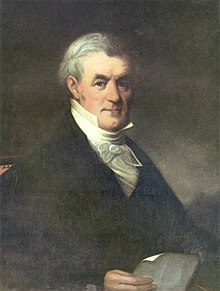William Eustis
| William Eustis | |
|---|---|

Portrait by Walter M. Brackett, 1873
|
|
| 6th United States Secretary of War | |
|
In office March 7, 1809 – January 13, 1813 |
|
| President | James Madison |
| Preceded by | Henry Dearborn |
| Succeeded by | John Armstrong, Jr. |
| 12th Governor of Massachusetts | |
|
In office May 31, 1823 – February 6, 1825 |
|
| Lieutenant |
Levi Lincoln, Jr. Marcus Morton |
| Preceded by | John Brooks |
| Succeeded by | Marcus Morton (acting) |
| Member of the U.S. House of Representatives from Massachusetts's 13th district |
|
|
In office August 21, 1820 – March 3, 1823 |
|
| Preceded by | Edward Dowse |
| Succeeded by | John Reed Jr. |
| Member of the U.S. House of Representatives from Massachusetts's 1st district |
|
|
In office March 4, 1803 – March 3, 1805 |
|
| Preceded by | John Bacon |
| Succeeded by | Josiah Quincy III |
| Member of the U.S. House of Representatives from Massachusetts's 8th district |
|
|
In office March 4, 1801 – March 3, 1803 |
|
| Preceded by | Harrison Gray Otis |
| Succeeded by | Lemuel Williams |
| Member of the Massachusetts House of Representatives | |
| Personal details | |
| Born |
June 10, 1753 Cambridge, Province of Massachusetts Bay, British America |
| Died | February 6, 1825 (aged 71) Boston, Massachusetts, U.S. |
| Political party | Democratic-Republican |
| Spouse(s) | Caroline Langdon |
| Alma mater | Harvard University |
| Profession | doctor, politician |
| Signature | |
| Military service | |
| Service/branch | Continental Army |
| Years of service | 1775–1783 |
| Battles/wars | Shays' Rebellion |
William Eustis (June 10, 1753 – February 6, 1825) was an early American physician, politician, and statesman from Massachusetts. Trained in medicine, he served as a military surgeon during the American Revolutionary War, notably at the Battle of Bunker Hill. He resumed medical practice after the war, but soon entered politics.
After several terms in the state legislature, Eustis won election to the United States Congress in 1800, serving as a moderate Democratic-Republican. He briefly returned to state politics after losing reelection in 1804, and was chosen to be Secretary of War in 1809 by President James Madison. Due in part to his inexperience at managing the army and a lack of preparedness, the military failures in the early months of the War of 1812 were laid on his shoulders, leading to his resignation.
Madison then appointed Eustis Minister to the Netherlands, a post he held from 1814 until 1818. After another period in Congress, he was elected Governor of Massachusetts in 1822. A popular successor to long-serving John Brooks, Eustis died in office in 1825. His Boston mansion, built in the 1750s by royal governor William Shirley, is known as the Shirley-Eustis House and is a National Historic Landmark.
William Eustis was born on June 10, 1753 in Cambridge, to Benjamin Eustis, a prominent Boston doctor, and Elizabeth (Hill) Eustis. He was the second surviving son of twelve children. He was educated at the Boston Latin School before he entered Harvard College, from which he graduated in 1772. While at Harvard he belonged to an undergraduate militia unit called the Martimercurian Band.
...
Wikipedia
